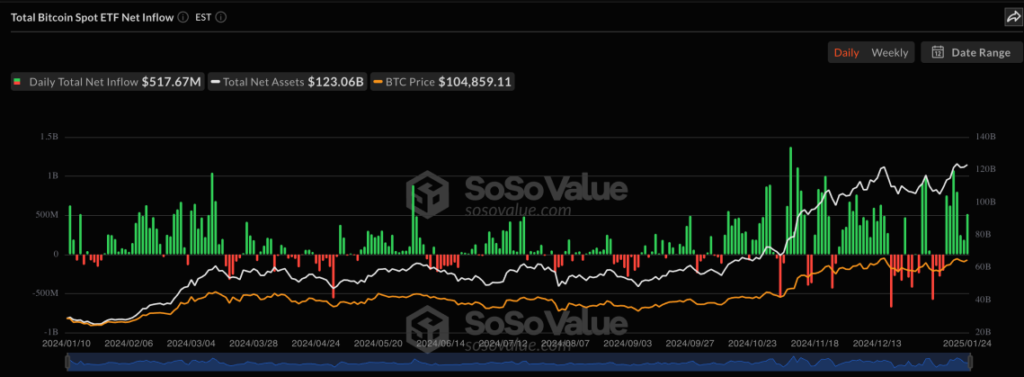During the last seven days Spot Bitcoin exchange-traded funds (ETFs) operating in the United States recorded capital inflows which surpassed $4.7 billion. Additional investors entered Crypto-backed financial instruments on Friday, January 24, contributing $517 million into spot Bitcoin exchange-traded funds.
The dollar inflow of $186 million in Fidelity’s Wise Origin Bitcoin Fund (FBTC) cemented its position as the second-largest Bitcoin ETF. During the latest funding period financial institutions directed $169 million to ARK 21Shares Bitcoin ETF (ARKB) with ARK 21Shares BTC ETF (ARKB) securing $169 million and BlackRock’s iShares BTC Trust (IBIT) receiving $155 million.
Bitcoin Price Remains Stable
The financial performance of Grayscale BTC Mini Trust (BTC) brought in $13 million and WisdomTree BTC Trust (BTCW) accumulated $2.79 million. Out of all the funds Bitwise BTC ETF (BITB) experienced the only negative trend since investors pulled $8.6 million worth of capital.

New capital inflows tracked BTC stable price point which spent the weekend valued at $105,000. Market analysts believe the ongoing capital inflows help preserve Bitcoin’s market value despite unpredictable market conditions. BTC showed minimal price change during the past day when trading reached $104500 on Sunday.
Investor confidence in BTC ETFs strengthened after Donald Trump became the United States president allowing renewed focus on these products. Professional analysts predicted institutional crypto adoption will keep building during 2024 based on current data that shows sustained market momentum since earlier this year.
The spot bitcoin ETFs quietly on fire to start year, with $4.2b in flows which is 6% of all ETF flows. Now at +$40b net since launch with aum at $121b and return of 127%. For context they just passed ESG ETFs in assets ($117b) and have about same as gold spot.
ETF analysis by Bloomberg shows that institutional backing for digital assets continues to grow because investors demand crypto-backed alternative funds. Nominal cryptocurrency demand stability is challenging since market elements combined with regulatory shifts might result in upcoming downfall prerequisites while ongoing seven-day demand patterns continue.








